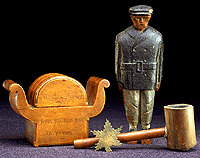
Carvings by prisoners of war
 |
Hand-carved box, 1838, made by William Reid; cherry wood; 9.5 x 4 x 6.4 cm. CMC 986.28.1 Carved figure, ca. 1944; carved wood, painted with oils; 12.5 cm. high CWM 28.4.238 Pipe, ca. 1941, made by R.P. Dunlop; bamboo; 11 cm. long, with bowl 2.6 cm. diameter CWM 4.7.86 Maple leaf pin, ca. 1942; brass sheet; 3 x 3 cm. CWM 28.4.238 Since the eighteenth century, Canadians have been, by turns, captives and captors. We have held or been imprisoned by Americans, Afrikaaners, Germans, Japanese, Chinese and North Koreans. The struggle of prisoners of war to keep up their spirits and maintain some semblance of a normal life has produced unexpected treasures, important both as records of historic conflicts and as compelling expressions of personal values. During the Second World War, as many as 35 000 German POWs were held in camps in Canada. Many of the prisoners took up whittling to pass the long hours. The unknown carver of the stalwart figure in the photograph gave it to one of the Canadian guards in a camp at Monteith, Ontario. An unnamed Canadian POW, taken prisoner in France at Dieppe, fashioned the patriotic maple leaf in a camp in Germany. The bamboo pipe was made by a Canadian employee of the Hong Kong Electric Company, who was taken prisoner by the Japanese after the fall of Hong Kong in 1941. More ambitious and complex than all of these is the wooden box with half-barrel lid and scrolled handles. It was made by a prisoner taken during the 1837 Rebellion in Upper Canada and held in the Toronto Gaol. While awaiting trial, many of the prisoners -- mostly farmers, artisans and mechanics, accustomed to working with their hands -- painstakingly carved little boxes from the firewood piled on the cell floors, using pocketknives or pieces of broken glass as primitive tools. |
